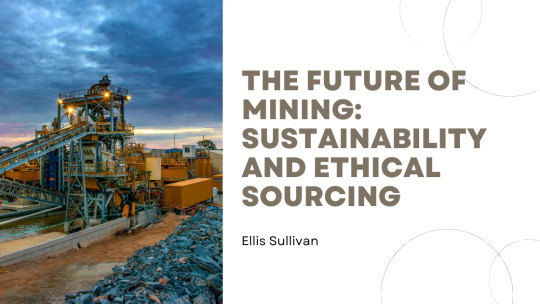Text
The Future of Mining: Sustainability and Ethical Sourcing

The mining industry is undergoing a profound transformation. As the global demand for raw materials like lithium, cobalt, and rare earth elements surges, driven by renewable energy technologies and electric vehicles, the emphasis on sustainability and ethical sourcing has never been more crucial. This shift is not just a moral imperative but a business necessity, with stakeholders demanding transparency and responsibility throughout the supply chain.
The Push for Sustainability in Mining
Mining has long been associated with significant environmental challenges, including habitat destruction, water contamination, and carbon emissions. However, modern technologies and innovative practices are paving the way for greener operations.
Renewable Energy Integration: Mining companies are increasingly adopting renewable energy sources such as solar and wind to power their operations. For instance, some mines in Chile and Australia now operate entirely on renewable energy, reducing their carbon footprint and operational costs.
Circular Economy Practices: Recycling metals from electronic waste and repurposing mining byproducts are becoming more common. These initiatives not only reduce the need for virgin material extraction but also address the issue of mining waste.
Water Management Innovations: Water is a critical resource in mining, often used in large quantities for processing minerals. Companies are investing in technologies to recycle water and reduce consumption, ensuring minimal impact on local communities and ecosystems.
Ethical Sourcing: A Growing Priority
Consumers and businesses alike are increasingly prioritizing ethically sourced materials. This trend has put pressure on the mining industry to ensure fair labor practices, community welfare, and environmental stewardship.
Fair Labor Practices: Reports of child labor and unsafe working conditions in some mining regions have raised global concerns. Ethical sourcing requires adherence to international labor standards and active monitoring of supply chains to prevent exploitation.
Community Engagement: Mining operations often disrupt local communities. Ethical sourcing involves consulting with and compensating affected populations, ensuring that mining benefits are shared equitably. Initiatives such as community-driven mining agreements are fostering collaboration and trust.
Transparency and Certification: Organizations like the Responsible Mining Initiative and Fairmined Certification are helping companies demonstrate their commitment to ethical practices. Blockchain technology is also being used to trace materials from mine to market, providing verifiable proof of ethical sourcing.
The Role of Innovation
Innovation is a cornerstone of the mining industry’s sustainable future. From automation and artificial intelligence to reduce waste and increase efficiency, to biotechnologies that use microbes to extract metals in a less invasive manner, the possibilities are vast. Additionally, partnerships with tech companies are helping mining firms harness data for better decision-making and improved sustainability outcomes.
Challenges and Opportunities Ahead
Despite these advancements, the path to sustainability and ethical sourcing in mining is not without challenges. High implementation costs, lack of regulatory frameworks in some regions, and the complexity of global supply chains are significant hurdles. However, these challenges also present opportunities for collaboration between governments, NGOs, and the private sector.
Conclusion
The future of mining lies at the intersection of sustainability and ethical sourcing. As the world transitions to a greener economy, the mining industry has a pivotal role in ensuring that the materials powering this change are sourced responsibly. By embracing innovation, transparency, and community collaboration, the mining sector can pave the way for a more ethical and sustainable future.
2 notes
·
View notes
Text

the real GC battle of men's cycling in 2025
75 notes
·
View notes
Text
The Health Benefits of Cycling: Why Every Business Leader Should Ride

In the fast-paced world of business, leaders often find themselves juggling endless responsibilities, tight deadlines, and high-stakes decisions. While staying ahead professionally is critical, maintaining peak physical and mental health is equally vital for sustained success. Enter cycling—a low-impact, highly effective exercise that not only boosts fitness but also enhances mental clarity, stress management, and overall well-being.
Here’s why every business leader should consider hopping on a bike:
1. Boosts Physical Fitness
Cycling is an excellent full-body workout that enhances cardiovascular health, strengthens muscles, and improves stamina. Unlike running, cycling is low-impact, making it gentler on joints while providing a calorie-burning activity. Regular cycling can help business leaders maintain a healthy weight, reduce the risk of heart disease, and increase overall energy levels—critical for staying sharp and productive during long workdays.
2. Improves Mental Clarity and Focus
The rhythm of pedaling combined with the meditative state induced by long rides provides mental clarity that few other activities can match. Studies show that regular exercise like cycling increases oxygen flow to the brain, improving cognitive function and memory. For business leaders, this translates to sharper decision-making, enhanced creativity, and better problem-solving abilities.
3. Manages Stress and Promotes Work-Life Balance
Stress is a constant companion for many professionals, but cycling offers an effective outlet. Whether it’s an early morning ride or an evening session to decompress, cycling reduces cortisol levels—the hormone associated with stress—and releases endorphins, the body’s natural mood enhancers. Moreover, cycling outdoors allows leaders to connect with nature, providing a much-needed mental reset that promotes a healthier work-life balance.
4. Enhances Networking Opportunities
Cycling has grown into a popular social activity among professionals and executives. Group rides, charity cycling events, and corporate wellness programs centered around biking are excellent platforms for networking. Engaging with peers in a relaxed, non-work setting fosters stronger relationships and opens doors to potential collaborations.
5. Sets a Positive Example
As a leader, your actions set the tone for your team. Embracing an active lifestyle demonstrates a commitment to personal health and resilience, inspiring others to prioritize their well-being. Encouraging team members to join in on cycling activities or promoting bike-to-work initiatives can foster a culture of wellness within your organization.
6. Accessible and Sustainable Exercise
Cycling is one of the most versatile exercises—you can ride on urban streets, rugged trails, or even stationary bikes indoors. It’s also an eco-friendly way to commute, aligning with modern values of sustainability and environmental consciousness. For leaders looking to reduce their carbon footprint, cycling offers an excellent way to combine fitness with purpose.
Conclusion
Cycling isn’t just a physical activity—it’s a holistic investment in your health, productivity, and well-being. For business leaders striving to perform at their best, the benefits of regular cycling extend far beyond the bike. It’s an opportunity to recharge, reconnect with oneself, and pave the way for a healthier, more balanced life.
So, grab a helmet, find a scenic route, and start pedaling. The road to better health—and leadership—is just a ride away.
0 notes
Text
0 notes
Text

Inchnadamph Bone Caves, Scottish Highlands
6K notes
·
View notes
Photo

Last light on the Matterhorn - Alpine Haute Route, June 2021
photo by: nature-hiking
11K notes
·
View notes
Text

“I sit beside the fire and think Of all that I have seen Of meadow flowers and butterflies In summers that have been"
― J.R.R. Tolkien
7K notes
·
View notes
Text

"Fairy Bridge" of Glen Creran, Appin, Scotland,
Credit: Caled Onianino
7K notes
·
View notes
















